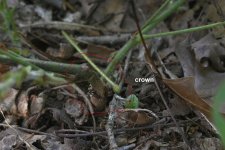OP
2manyrocks
Super Member
- Joined
- Jul 28, 2007
- Messages
- 9,516
Roughly one year update---
The kudzu has not recovered in places where I was able to remove the tubers. However, the challenge was in finding all of them to remove them. There were areas where I thought I had gotten them all removed only to find them growing this season, but overall, the situation has improved. It's a pain, but a pickaxe can be used to remove tubers.
I used Milestone herbicide as recommended by Dr. Weaver in some areas, and it appears more effective at killing the kudzu than glysphospate.
The kudzu has not recovered in places where I was able to remove the tubers. However, the challenge was in finding all of them to remove them. There were areas where I thought I had gotten them all removed only to find them growing this season, but overall, the situation has improved. It's a pain, but a pickaxe can be used to remove tubers.
I used Milestone herbicide as recommended by Dr. Weaver in some areas, and it appears more effective at killing the kudzu than glysphospate.

